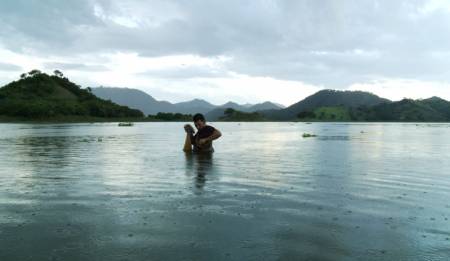-
Tatiana Huezo: The Tiniest Place (2011)
Tatiana Huezo: The Tiniest Place (2011)

THE TINIEST PLACE IS ALSO A SINGULARLY BEAUTIFUL PLACE
Poetic documentary about people, a village, survival of civil war
The village of Cinquera, El Salvador, on the edge of the jungle, is a place haunted by the ghosts of a brutal civil war. In the years between 1980 and 1992 Cinquera was virtually annihilated by the National Guard because they thought it a haven for the liberation front, the Frente Farabundo Martí para la Liberación Nacional. Now decades later survivors of this onslaught have returned to bury their dead and have rebuilt the town from what remained. Under the rightist government Cinquera was officially removed from the charts. Over the country as a whiole there were perhaps eighty thousand deaths and tens of thousands who disappeared. Now Cinquera is a town again, with a school, a band, and lots of cows.
Tatiana Huezo is a young Mexican documentary filmmaker who was born in El Salvador. In this superb debut feature she paints a portrait of the whole village and its collective personality. She does that by observing villagers recalling their ordeals, which include all kinds of brutalization and cruelty, causing madness. An old woman still talks continually to her deceased daughter. In fact many who escaped from the town into the forest joined the FMLN. Its flag still flies on the sides of some houses. Likewise the film documents the persistent spirit of the people, who have not been beaten by the brutalities of the National Guard.
Huezo and her fine cameraman Ernesto Pardo and assistant editors Paulina del Paso and Lucrecia Gutierrez have woven a poem out of the vivid recollections and self expression of seven witnesses, young and old, of the civil war years. The images show them doing things, while their voices are heard. Huezo revels in the sheer joy of collecting images and sequencing them, building up a narrative, a picture, that flows as naturally as the seasons, from a rider on a bicycle to men exploring a cave where they lived with six families for three years hiding from the national guard, to the mother whose young daughter joined the rebels and then was taken away and brutally killed. She coaxes her hen to nurse eggs she buys in the town into chicks. One man is a great reader, who meditates and studies and writes notes. Of the two in the cave the son stayed behind when the guards found them, walking deeper and deeper in among the bats, horrified at being caught as the others were and equally horrified at what fate might await them. The older man was taken to be hanged. Evidently somehow he survived.
The mother compares her daughter to a lightning bug. She was a light. She may survive there as a lightning bug. They are content now, she and the spirit of her daughter, she says, now that she is back in the village. When they all left to hide in the forest or were killed and the village fell off the official maps, the frogs remained. Now there are cows, and the film ends with the birth of a calf to a cow owned by one of the witnesses. And then the rains come, and he walks through the streets with a joyful smile. Thus the film shows the durability of the human spirit. These people carry their traumas with them all the time, but they have prevailed and the spirit of the village has been reborn.
Watching this film is a profound experience and an aesthetic pleasure. Tatiana Huezo is a most gifted filmmaker. In his review of The Tiniest Place for Variety, Robert Koehler, who calls the film "sublime," writes, "The subject of the Central American wars of recent decades have rarely received such a level of artistic treatment onscreen... The result is one of the most impressive debuts by a Mexican filmmaker since Carlos Reygadas' 'Japon,' both linked by an audacious embrace of cinema's power to prompt the deepest thoughts and feelings." Koehler points out that Heuzo trained at Barcelona's Pompeu Fabra school of nonfiction filmmaking, "whose tradition of poetic images and rich textures is vividly on display here," but he also remarks that the film is very much of its place and very much a personal statement, the filmmaker's own grandmother being from Cinquera.
Besides the eloquent speakers and the rich ambient sound (including frogs, livestock, bats, and insects), there is singing by an old lady, the music of a youthful marching band, and an understated score by Leonardo Heilblum and Jacobo Lieberman.
This film is many things: gorgeous, supple cinematography; amazing interviews in which all the speakers become eloquent beyond a documentarian's wildest dreams; a brilliant overall conception and sense of the place and its history and its people; and editing that paints fluently and joyously -- reveling in its sheer natural mastery of cinematic technique -- with all this material to create a rich and living portrait. Anyone who wants to see all that documentary filmmaking can be at its best must seek out the remarkable The Tiniest Place.
El lugar mas pequeño seems destined for an illustrious history that is just beginning. It was shown at the Festival Ambulante at Mexico City in February 2011 and its first Stateside showing and international premiere is at the San Francisco International Film Festival, where it was screened for this review.
SFIFF Screenings
Sat, Apr 30 6:00 / PFA
Sun, May 1 4:15 / Kabuki
Thu, May 5 5:45 / Kabuki
Last edited by Chris Knipp; 05-04-2015 at 11:15 PM.
 Posting Permissions
Posting Permissions
- You may not post new threads
- You may not post replies
- You may not post attachments
- You may not edit your posts
-
Forum Rules





 Reply With Quote
Reply With Quote
Bookmarks